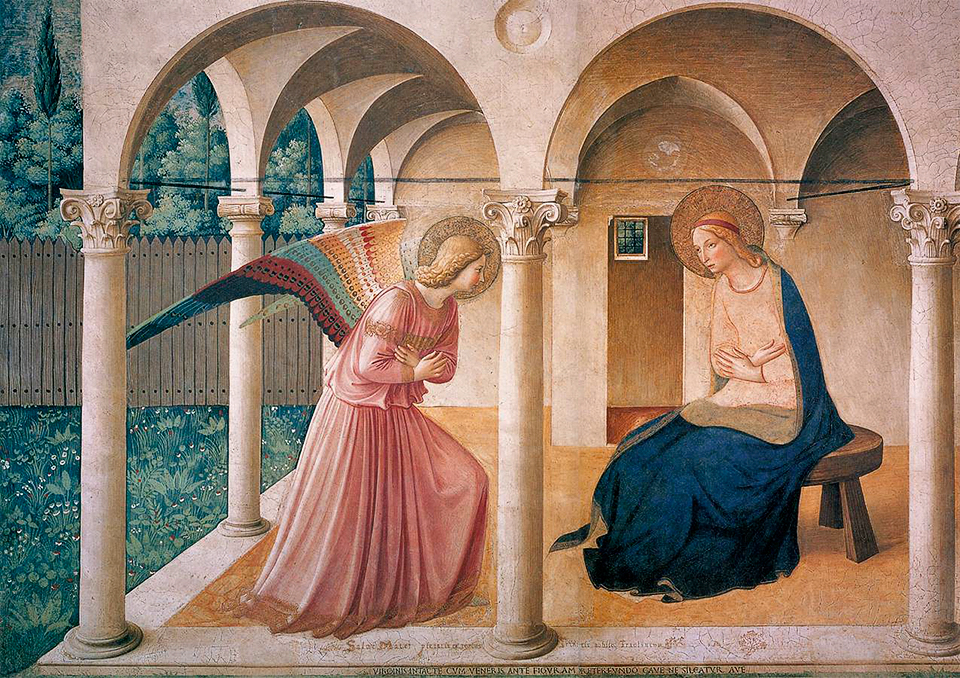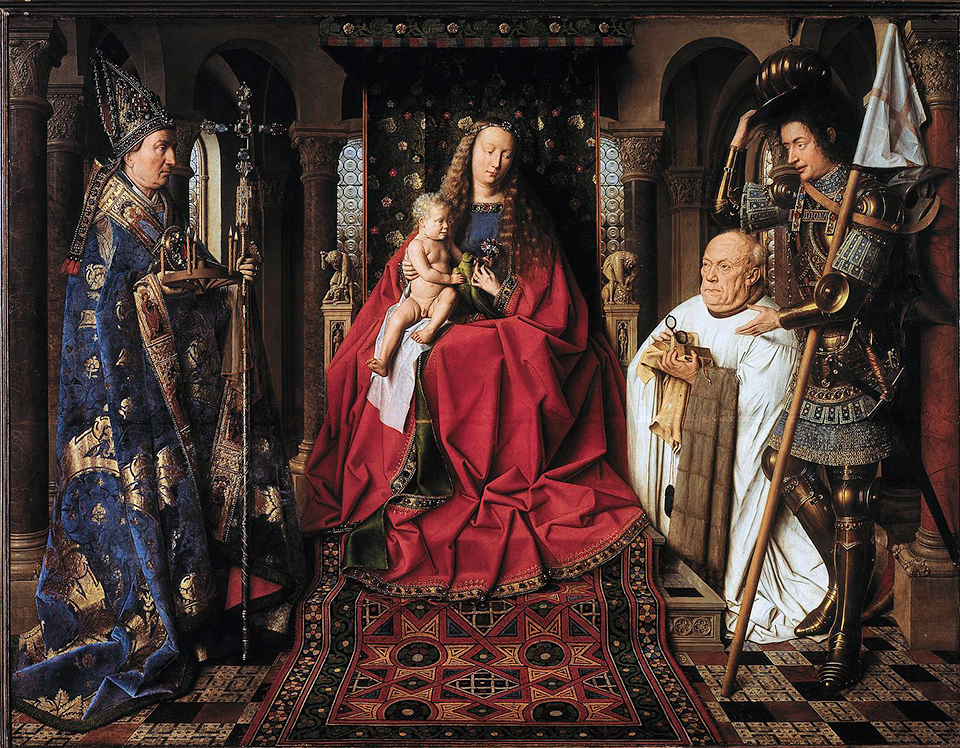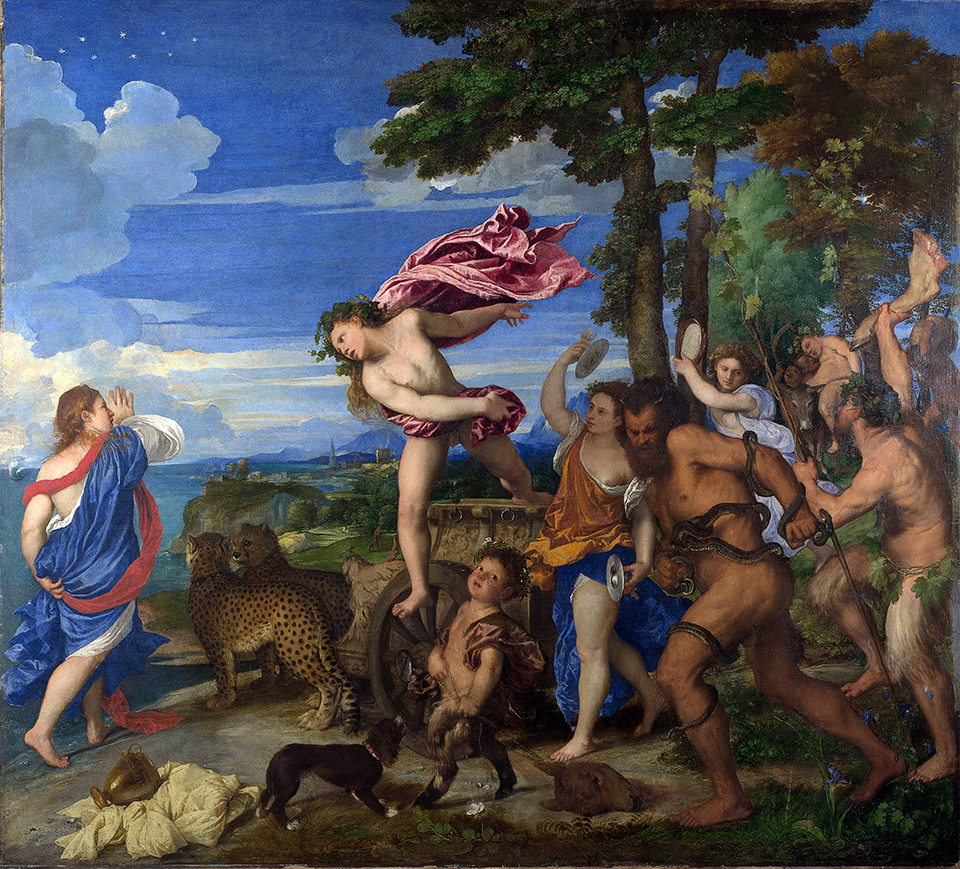Fra Angelico, The Annunciation, ca. 1440–1445, fresco, 5.5 ft. x 6.25 ft., Convent of San Marco, Florence, Italy. Fra Angelico dedicated his work exclusively to religious subjects as he understood art to be an aspect of religious devotion intended for contemplation and meditation. The artist’s masterpiece integrates the late Gothic Italian style with the new language of the Renaissance and recent discoveries of geometric perspective. Combining an architectural setting with landscape in the background, and fully formed human figures occupying the space added a narrative element and would forever change picture making.
Representational artists all share one common goal – to present an illusion of volume, accomplished in painting through the juxtaposition of dark and light values, and of highlights and shadows.
Although there are many variations on the execution, this illusion is accomplished traditionally through one of four basic techniques, each with historical significance and identifying characteristics, each with its own master artists, adherents and followers, and each predicting the evolution of its beneficiaries while guaranteeing a place in art history for its antecedents. But first, a bit of that art historical context.
No. 1: Basic technique – direct painting approach. In this most basic and very effective technique the artist, using a small brush and with carefully placed single strokes, applies light and dark valued color mixtures directly onto the surface of the panel. Dark values indicate shadows and light values indicate highlights. There is no blending of similar valued paint strokes into the surrounding pigments, and the surface reveals individual brush strokes that are clearly defined, retaining their original color mixtures. Typically the medium used was pure egg tempera on panel; later egg and oil. It was the Italian artists that mastered the technique, and eventually organized into guilds that promoted a systematic and deliberate working method. Pure egg tempera panel paintings date from prior to 1400 – known as the ornate International Style – whereas those painted from 1400 to 1500 might be either pure egg tempera, or a combination of tempera and oil. The technique of painting in egg tempera was very demanding, and combined great skill and careful craftsmanship. The Italian artists and their guilds produced a masterful body of tempera paintings and a great many have survived to present day in good to excellent condition. Works by 14th and 15th century Southern European Italian painters including Cimabue, Giotto, Vivarini, Fra Filippo Lippi, Fra Angelico, Sassetta, Mantegna, Ghirlandaio, and Botticelli are examples of the technical and artistic virtuosity of the direct painting approach.
These Italian artists broke the mold of their predecessor’s iconic, stiffly stylized, unreal and other-worldly figures and compositions by manipulating the effects of light and shade to communicate a sense of “reality” to the viewer. Sacred backgrounds were replaced with earthly settings mindful of symbolism and meaning. The Trecento artists used brushstrokes of light and shade to draw attention to the realness of the human form by emphasizing bodily curves, bulk and muscles. They painted real people with weight and form that were subordinate to the laws of gravity. Although the use of direct painting in tempera continued through the 15th century, by the beginning of the 16th century the materials and working methods of oil painting were sufficiently developed, understood and readily available. In the North however, things were brewing in the studios and ateliers, and within a very short time, egg or egg/oil tempera fell out of fashion and pure oil painting became the primary form of easel painting throughout Europe.
Jan van Eyck Virgin and Child with Canon Joris van der Paele, 1436. oil on oak panel, 4.625 ft. x 5.75 ft. Arguably the most elaborate and impressive demonstration of the artist’s fascination with optical concepts and effects, Van Eyck had a profound influence on European painting. This materpiece depicts Van der Paele, a wealthy canon of the Church of Saint Donatian in Bruges, kneeling before the enthroned Virgin and Child, flanked by Saint George and Saint Donatian. Van Eyck perfected a new technique of painting in oils that enabled him to achieve an unprecedented realism in rendering materials in glowing color. Groundbreaking achievements include the realistic figures, individualized portraits, play of reflections on the helmet and the brilliant differentiation between qualities of texture, as in the fabrics and brocades for example. A wealth of minute details are brought together in a convincing suggestion of spatial perspective.
No. 2: Transparent oil technique. Although the beginnings of oil painting are recorded as early as the 12th century in Northern Europe, it was the virtuoso handling of the medium by the Flemish and early Netherlandish masters that represented a major turning point in the adoption of oil painting as the dominant painting medium in Europe. With this more complex, systematic approach combining extraordinary realism with brilliant color, artists quickly discovered that the oil and pigment admixtures made most pigments translucent, allowing them to apply their colors in thin layers, or glazes, thereby generating the rich, glowing colors associated with the portraits of Jan van Eyck and Rogier van der Weyden.
These artists, like the group that preceded them, also perceived painting as a structured multi-layered construct that, from inception to completion, separated color and form. The artists were very knowledgeable in the optical properties of both light and color, and worked on a highly reflective white ground layer composed of chalk or marble dust mixed with glue, applied in many coats and burnished smooth between coats. The underpainting resembled a white and gray monotone version of the finished image with fully developed forms, painted in much the same way as the tempera artists that preceded them. Another technique utilized an underdrawing completed with fine brush strokes, some type of stylus, ink, or oil and black pigment. This was then covered with a thin transparent layer of umber-colored paint, or imprimatura, which allowed the drawing to show through thus establishing a mid-tone neutral color over the entire surface. White highlights were added as necessary, expediently creating a complete value range and a finished monochromatic underpainting. What is important to note here, regardless of the method used, is that the underpainting was an essential component of the structured approach.
The painting was then completed by applying transparent glazes of color over the fully developed underpainting which defined the forms, the color remaining pure and luminous. The lightest lights were rendered with extremely thin applications of local color mixtures, with no visible brushstrokes. The underpainting whites were tinted appropriately with thinned oil and pigment. Since it was customary to leave no underpainting showing, darks had to be glazed rather thickly, using multiple layers of built up paint. This approach interestingly, foreshadowed the next technique, culminating in the dazzling technical virtuosity of two of the greatest master painters of the 16th century.
Titian, Bacchus and Ariadne, oil on canvas, ca 1520-1523, 5.75 ft. x 6.25 ft, National Gallery. London. The vibrant colors and striking contrasts, coupled with the dynamic arrangement of figures is a masterpiece of the High Renaissance. Titian’s command over composition and use of color are hallmarks of a period that blends realistic human emotion and anatomical correctness with an idealized beauty. The background showcases a serene landscape that seemingly contrasts the primary scene, creating a balance between the human figures and nature. Titian’s paint surface is characterized by loose, colorful brushwork and the dragging and smudging of the paint over the canvas creates vibrant, nuanced effects that animate the emotionally charged scene. Although appearing chaotic, the image is well composed consisting of two diagonals running towards Ariadne on the left. At the bottom left of the picture, in the overturned goblet, Titian, the most important Venetian painter of his time, has hidden his signature.
No. 3: Highlighting with impasto white. Tiziano Vecelli or Titian, the preeminent and influential Venetian painter (1485 -1576) developed a new way working with the revolutionary van Eyck oil medium. Whereas the northern master’s techniques were suitable for smaller panel paintings, their highly lustrous and reflective surfaces posed problems for the southern European painters, and did not suit the needs for larger mural-style works that needed to be painted on linen canvas supports. Titian’s technique, briefly, was to start off with a reddish-dark brown earth background, slowly building up the layers by creating a underpainting grisaille in white and gray and finishing in opaque layers with full color translucent and colorful glazing.
Titian discovered a medium that allowed a freer painting style that facilitated larger formats, combined with an ease of blending and would work on any support with or without any preliminary drawing. In this way, Titian was able to create, for the first time, a soft smokelike blending of edges into background passages, called sfumato. This invested the composition with an airy feeling flowing over the surface of the work, harmonizing edges into the background. Due to the addition of beeswax into his oil medium, possibly a black oil mixture of some kind, the matte finish of his work mitigated the objectionable reflective surface typical of the northern European masters. The new medium was also slow-drying, allowing the artist to easily cover, blend and modify large passages while still wet and tacky over a lengthy painting session.
In this technique the artist tones the surface with a thin reddish-brown middle or darker value layer. This layer is called an imprimatura and it literally means first paint layer in Italian. He then creates an underdrawing serving only as rough guide, which might then be disregarded during the development of a painting. On top of the underdrawing Titian would directly “sketch” over the image using a small brush and thinned paint, restating the linework as necessary to refine the composition. The artist would then commence with a completely modeled white and gray-toned underpainting of the figures, sometimes using very thick impastos; other objects to be painted lighter would also be underpainted in white, though not as thickly painted or modeled to the degree of finish as the figures. The lead whites, once dry, would then be painted over with translucent veils of color, called velaturas, and transparent glazes, softly blending into darker glazed passages. Directly painted passages of colors mixed with white and or opaque colors were use for other elements throughout the composition harmoniously unified into the painting surface through the use of his “magic” medium.
More in Part 2.



2 Responses
You’re truly a wealth of knowledge, and the granular detail you know about the materials, process and context of these seventeenth century pieces never ceases to amaze me. I also greatly enjoyed the paintings that are newer to me (which were most)–looking at that Baccus and Ariadne, I can’t help but think I should rely much more on paintings than I have to teach mythology. So many of the literary regurgitations and summaries are just perfunctory works compared to vivid works of the imagination like this.
Thanks much for the generous comments Rory. -P